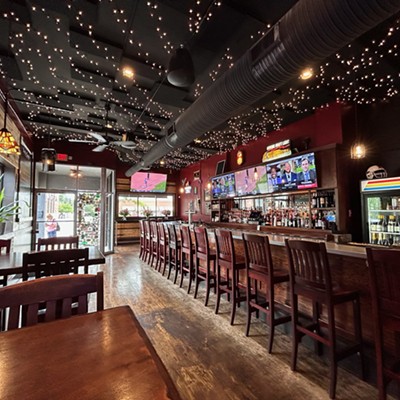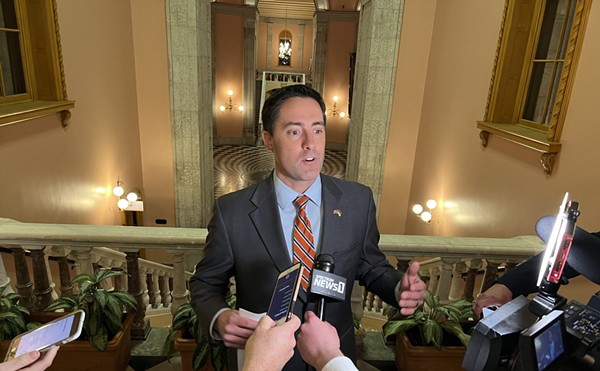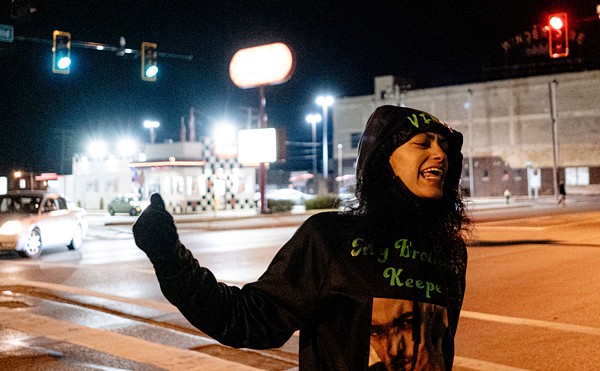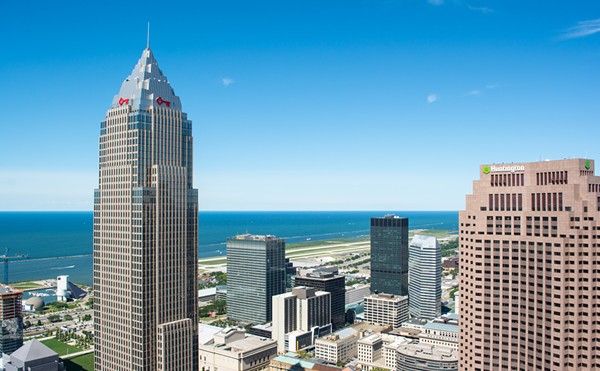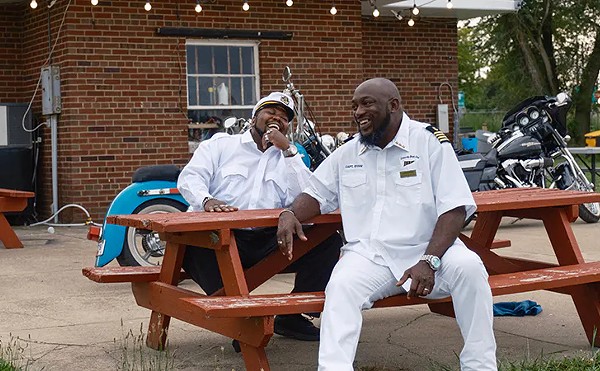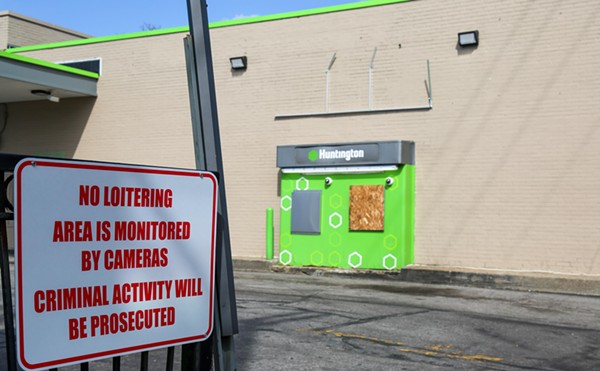The luxury lounge chair is decadent and depraved
The increasingly popular luxury reclining chair is a scourge on the moviegoing experience. Featuring heated seats, padded footrests and leather upholstery, these reservable, oversized, electric-powered armchairs have been installed incrementally at the country's major movie theater chains. In Greater Cleveland, one can "kick back" and "immerse [oneself]" in them at Regal Entertainment Group's Crocker Park and Willoughby Commons, AMC Entertainment Inc.'s Westwood Town Center and Ridge Park Square, and Cinemark Theatres' Valley View and Strongsville at Southpark.
Luxury reclining seats have changed the way we see movies in three important ways: 1) They complicate the ticketing process. 2) They drastically reduce auditorium capacity. And 3) They represent a new hierarchy of values where individual comfort is prioritized at the expense of movies themselves, not to mention the enjoyment of communal viewing. This is all bad.
The luxury lounge chair complicates the ticketing process
The midnight premiere of Harry Potter and Half-Blood Prince, in July 2009, remains the single greatest moviegoing experience of my life. It was also the most crowded. I arrived at Valley View with my mom and two sisters when the sun was still high in the sky, and we joined a line that snaked from one of several visible nuclei within the theater out into the parking lot.
Everywhere, fans were donned in elaborate Harry Potter costumery. Though this was before cosplay took off in the mainstream, watching robed adults dueling with plastic wands occasioned no discomfort or weirdness. That sort of behavior was customary at the late-night screenings. This was pre-2014, before movie studios slackened their interpretation of the weekend gross, and "midnight premieres," which were still being marketed to and attended by film franchises' most ardent fan bases, actually referred to premieres at midnight. The excitement of seeing a long-awaited release — in Half-Blood Prince's case, one that had been twice delayed already — was rarefied by the hour.
That night, in an act of what still seems to me like surrender, the Valley View management permitted at least one auditorium capacity's worth of guests into their seats several hours before showtime to reduce the swelling of the crowd outside. My family was among this cohort. We thundered like escaped cattle along the speckled carpet and up the auditorium's non-uniform steps to claim our chosen seats. I was a young, spry college boy at the time, and managed to plant a flag at our desired location first: prime middle seats in a central row. All around us, hundreds of other salivating Harry Potter diehards were doing the same, flinging purses and articles of clothing to save seats for loved ones further back in the herd. This was all exhilarating and wonderful and totally in keeping with the evening's giddy electricity.
But at the major multiplexes, this doesn't happen anymore, even for Thursday night "premieres." That's because of luxury seats, and an element that underpins the second-most common argument — in my view, the strongest argument — in their favor: the fact that they are reservable.
Online, one can purchase tickets an hour or a week in advance and avoid the clamor of the box office. This is a convenience that redounds to the benefit of both customers and theater staff. Customers obviously don't have to bother with long lines because the reservations are no longer general admission: Specific seats are attached. Patrons can arrive 30 seconds before showtime and stroll to the seats they hand-selected days earlier, seats that, in years' past, they might've had to arrive 30 minutes or more beforehand to snag. The convenience is most pronounced at blockbusters on opening weekends, which is when the vast majority of Americans go to the movies. The online reservations are also beneficial for theater staff. Even though major openings are still frenzied and anarchic, particularly for releases that rise to the level of cultural events, like 2015's Star Wars: The Force Awakens, there's less pressure to marshal ungainly lines and process patrons at the ticket boxes.
But in practice, the supposed customer convenience of online reservations is undercut by a host of impractical ramifications.
For one thing, many people who go to the movies enjoy doing so in groups. And unless you are in a financial position to buy tickets for your entire group (if you are a parent, say, buying tickets for yourself and your kids), the buying experience is a humongous pain in the ass.
If you're planning to see The Last Jedi, which opens Friday, with two adult friends, and you all intend to pay for your own ticket, and you're of the school where sitting by your friends is desirable — which I'll assume you are, because otherwise why are you even going together? — you'll have to simultaneously text or chat with your companions as you navigate the online steps. Like other sorts of negotiations pertaining to logistics, this is maddening and laborious. "Row D or row E, guys? Guys? Are we okay with row D? Or actually, would we prefer the middle of F? The D seats are kind of off to the side? Guys?" But you've got to do it, because if you don't all buy your tickets at the same time, (if one of your friends is a routine procrastinator, say) you simply won't be able to sit next to each other. For major premieres, these theaters fill up quick.
"But that's what Venmo is for," many of you will rejoin triumphantly. Why not just have one person buy the tickets and get reimbursed?
To that I say: Be my guest. But note that primetime movies ain't chump change these days, and if you've got a friend who is not only a routine procrastinator but who also routinely "forgets" to Venmo you back, or who says things like, "I'll pick up the popcorn," and you get the sneaking suspicion that he means, "I'll pick up the popcorn in lieu of paying you back for the ticket," boy, does it get dicey in a hurry.
These inconveniences are often almost unmentionably minor. I attended It on the Sunday of its opening weekend in September with a group of friends who changed their minds about the configuration of their seating arrangement after I'd reserved my ticket. This was by no means an insurmountable issue, but it wasn't ideal. I almost certainly would've moved to the other end of the configuration if given the opportunity. But once you purchase your seat (and I'll trust it goes without saying that I resent the online surcharge), you're stuck there. This precludes the possibility of determining where you'd like to sit, and amending your determinations, once you're inside the auditorium.
I can't be alone on this. Everyone has seating preferences, of course — I myself prefer to sit closer to the screen than the average moviegoer — and those preferences are easy enough to adhere to when buying tickets online. But every venue is different. Certain screens are angled ever so slightly, such that a seat or two to the left or right might present a better vantage. Other obvious factors come into play as well. Sometimes, after plopping down, we realize that we're a tad too close to the screen and would prefer not to strain our necks so much. Sometimes we find ourselves in the code-red position of being directly behind texting teens whose screens glow and psychedelically pulse through the previews, and we want those phones out of our sightlines pronto. Sometimes, we are joined by a late-arriving additional guest — though spontaneous last-minute invitations are now history — and we'd like to shift our grouping down a few seats to retain a central position. Again, these are all small adjustments, but they are also totally standard. And they are no longer possible.
All of which, it has been argued to me, is small potatoes. People have to deal with suboptimal seats all the time, my friends advise, so quit whining. (Virtually everyone I've spoken to about these matters is enthusiastically pro luxury seating, by the way.)
But it's just a fact that not everyone is on the same page with the new model. Many moviegoers continue to make the minor seating adjustments mentioned above in spite of their reservations. And while I personally regard with distaste the visual sensation of entering an auditorium and gazing upon rows of recumbent adults, most of whom are scrolling through social media feeds with the despondent glaze of dialysis patients in Hour 4, what's even more distasteful is the prospect of confronting one of these recumbents and having to go through the excruciatingly awkward, public process of comparing tickets in low light — which, good luck even finding your ticket, now that it's wintertime and there are about 18 pockets it might've gotten into -- and then, when the recumbents refuse to move or reciprocally fish for their ticket (some folks being pretty militant and territorial despite being in the wrong), of trying to weigh whether or not it's worth tracking down a flashlight-toting theater manager and making a bit of a scene, or just shrugging your shoulders and sitting someplace else, someplace unwanted, so that the chances of your occupying someone else's reserved seat are as remote as possible. This is a nightmare.
Dear friends of mine have argued that these confrontations, which (because they don't go to the movies as often as I do) they regard as mostly theoretical, beat the abhorred, if universal, practice of "seat-saving." They know that my revulsion for seat-saving (and line-jumping) is deep and inbred, but I have to say I prefer my quiet contempt for seat-savers to these new disputes. Only on very rare occasions does seat-saving malcontentment lead to verbal argument. Everyone agrees that people who save seats ought to be banished to North Korea, but everyone also agrees (with the exception of my dad, for whom seat-saving is as flagrant a violation of the social contract as tax evasion) that saved seats ought to be honored. This is because we've all done it before ourselves, malcontentment notwithstanding. I admit that at the premiere of Half-Blood Prince, my sister and I actually locked arms, protecting a seat between us for our little brother, who was hauling ass from a summer musical rehearsal and was still 30 minutes out.
All of the logistical headaches inherent in the current ticketing model are exacerbated by the second problem.
The luxury lounge chair has drastically reduced auditorium capacity
In the summer of 2015, on a free weekend evening, I drove by my lonesome to Valley View to see Straight Outta Compton, which I was eager to catch in its second weekend despite early mixed reviews. I made no reservation. To my surprise, the showing that I planned to attend (probably 7:00 or 7:30 p.m.) was sold out. Standing at the kiosk, I observed, with even greater surprise, that every showing for that evening was sold out as well. The movie had performed fairly well at the box office — in its second weekend, the film grossed a respectable $26.4 million, good for the top spot on the charts — but not that well. This was by no means sell-out material. Dismayed, and having already seen Mission: Impossible - Rogue Nation, I went home.
I recently told this story to a friend, who conveyed a similar experience he had last year, also at Valley View, with the Oscar-nominated Fences, based on the play by August Wilson. Not only was the showtime that he planned to attend sold out; so, too, were showtimes later in the evening. This was Fences, a film that never eclipsed the No. 6 spot on box-office charts during its theatrical run, overshadowed by the likes of Rogue One, Sing, Moana and, eventually, Hidden Figures.
Maybe this is smart economics from the theaters' perspective. Maybe they have nailed a supply/demand sweet spot, the goal of which is to generate as few empty seats as possible. But these movies just shouldn't be selling out. It'd be like planning to attend a Wednesday night Indians-White Sox game, in April, with Josh Tomlin on the mound, and finding no tickets available.
It's not because these films don't deserve bigger audiences. They often do. But that's why luxury seating, and the resulting reduction in auditorium capacity, is a problem. The same factor which is making non-blockbusters sell out when they shouldn't is eliminating non-blockbusters from the lineup when blockbusters come to town.
Because movie theaters make their money on refreshments (which are fiendishly consumed by early-arriving patrons at hotly anticipated releases); and because movie theaters have every right to maximize their profits by maximizing crowd size on the weekends of hotly anticipated releases; and because, thanks to oversized luxury reclining chairs, auditoriums now seat roughly half as many asses as they used to, theaters must now devote twice as many screens to showing hotly anticipated films.
Check your local listings this weekend. Count how many screens the likes of Crocker Park, Ridge Park Square and Valley View devote to The Last Jedi. You'll notice that, to make room for the big-money premieres, indie films and middling performers get sacrificed. In extreme cases, everything else gets sacrificed. Maybe Lady Bird and Three Billboards Outside Ebbing Missouri and Roman J. Israel Esquire will share a single screen at these venues this weekend. Or maybe they'll disappear entirely.
Beyond the fact that having more than one option at a multiplex is preferable from a consumer's perspective, the continual presence of many and diverse voices enhances the vibrancy of the art form. If we're serious as consumers and advocates about supporting an environment where diverse voices can thrive in the film industry, we must choose to hold studios accountable. With our ticket-buying habits, we can help send the message that women and people of color need to be represented on both sides of the camera in major blockbusters. 2017's Wonder Woman, directed by Patty Jenkins; 2018's Black Panther, directed by Ryan Coogler; and A Wrinkle in Time, directed by her majesty Ava DuVernay, are striking examples of a positive trend. But it also means supporting films at lower levels.
Cinema, like the United States itself, has a shrinking middle class, and luxury seating may accelerate its demise.
The luxury lounge chair represents a new hierarchy of values where "comfort" is prioritized at the expense of movies themselves, not to mention the enjoyment of communal viewing
My argument's final tentpole is perhaps the least stable. Or, in any case, it's the one on which I've received the most pushback from friends. (Recall that just about everyone I've talked to about this tells me I'm smoking something.) But it's the crux of my personal objection. It is the idea — the fear, really — that the reclining luxury lounge chair may be too comfortable.
I first encountered this fear at a press screening for 2016's Arrival, which would become my favorite film of the year. Viewed on Valley View's XD screen, the experience was marvelous, breathtaking even. But it was sullied by the fact that, two seats over, another local film critic was audibly snoring, conked out in the warm and cozy comfort of his recliner.
Above, I mentioned the sensation of entering an auditorium and observing rows of recumbent adults, who are typically not only thumbing their mobile devices, but also mindlessly ingesting the nachos or popcorn atop their bellies. (Note: I do this too.) It's the closest approximation of the bloated Buy N Large consumers of Pixar's Wall-E that America has yet produced, and that's a comparison we should all regard with real disquiet, if not horror.
Nevertheless, far and away the most popular argument I hear in favor of the reclining seats is that they are really comfortable. They are, I'm told, super comfortable. They are plush. They are deluxe. They are exactly what they purport to be: luxurious.
Here, for example, is how the major chains have recently marketed these new seating options.
From AMC: "The power to relax is in your hands. Seat warmers make it cozy, AMC makes comfort easy! Take your movie experience to the max when you tilt back & sink in to the comfort now reclining near you!"
From Regal: "Kick back and enjoy Regal King Size Recliners at select movie theatre locations. These luxurious recliners are cozy, comfortable and spacious, adjustable to multiple positions and include padded footrests. Regal guests can rest and relax in these movie theatre recliners, becoming further immersed in the movie while experiencing this luxury environment."
The seats are supposed to help us "kick back," "sink in," "rest and relax." In short, they facilitate our ability, and encourage our proclivity, to lounge. I agree with my friends who insist that these seats provide unprecedented comfort. I just don't feel that's a 100-percent positive thing (especially when seats at the major chains were already pretty daggone comfortable). When I go to the movies, lounging is not at all what I'm trying to do. I note without irony or cheek that we describe ourselves in states of eagerness as being "on the edge of our seats." That's because when we're excited about experiencing something, we incline toward that experience. We look forward to it.
And I don't know about you, but accidentally falling asleep in a "luxury environment" is not how I "further immerse myself" in a movie. In fact, it's the opposite. It's how I further immerse myself in a chair. I think this is why I have no bones whatsoever — yet! — about technological enhancements to theater screens: 3-D, IMAX, trillion-color XD. Bring 'em on. Those advances seemed designed to improve movies themselves. Not so with luxury seating.
Even if they're not designed specifically for this purpose, luxury reclining seating makes it easier to ignore the movie. Among other things, they make it easier to keep social media browsing discreet, and they make it easier to snooze. (I myself drunkenly snoozed through a late-night screening of 2015's Ant-Man at Ridge Park Square, which I'm not proud of.) They also make it much harder to quickly jet to the bathroom. You find yourself trying, and usually erring, to straighten your seat with the confusing buttons and then waiting as the slow electric whir returns you to an upright position.
Most distressingly of all, the seats have a profound atomizing effect. Due to their expansive size, and the correlative growth of row width to allow for reclining, one never has the sense, anymore, of being in a really crowded theater. It sometimes feels like you're all alone.
And if going to see Fences is like a midweek baseball game in April, going to see The Last Jedi should be like the World Series. I'll submit the fact that extraordinarily fun, competitive regular-season sporting events are described as having a "playoff atmosphere," an atmosphere that generally connotes a higher level of competition — which makes for higher-quality viewing — and loud, engaged crowds. A playoff atmosphere is never a bad thing.
I need not specify that people spend inordinate amounts of money on tickets to playoff games. But it seems pertinent to ask why on earth they do so. Is it for the luxury of avoiding a long line and sitting in a comfortable seat where it's easy to tune out one's surroundings? Certainly not. Those tickets are so expensive because of economics, because so many people want them. And being part of a crowd, an engaged and exuberant and exclusive one, is what makes playoff games so thrilling.
I submit energetically that experiencing something joyful — or funny, or scary, or fantastical — in communion with others is a rare and wonderful thing, and that the communion itself heightens the experience. This is why I cherish so many of my moviegoing memories over the years. And from that rich pool of memories, not a single one concerns the upholstery or cushioning of the chairs I sat in. The communion, with both my family and with total strangers, was certainly what made Harry Potter and the Half-Blood Prince so special. I remember vividly clutching my sister's hand as the iconic WB materialized out of the darkness on screen, and the auditorium, altogether, inhaled.



